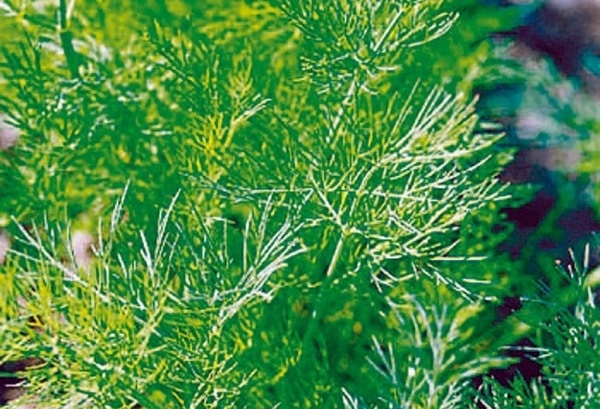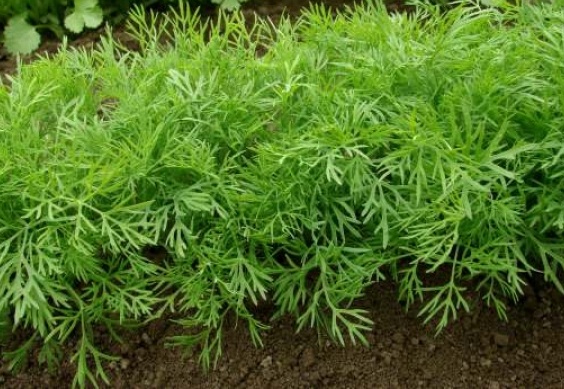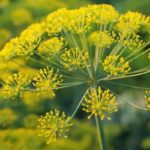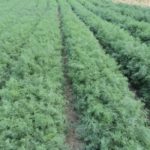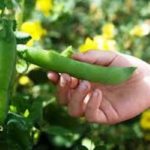Gribovsky dill can be found in many garden plots, which is largely due to the unpretentiousness of the garden crop and the presence of a number of undoubted advantages in this variety compared to other varieties. To get the full benefit from a garden crop, it is recommended to learn in advance about the main advantages and rules for growing a plant.
Description of the variety
The description classifies the variety as a variety of annual crops. A distinctive quality of the plant is considered to be its good ability to tolerate low temperatures and quickly recover from stressful situations.
Dill of this variety is considered early ripening and the greens can be harvested after 35 days from the moment the first shoots appear.
Compared to late-ripening species, the crop has a slightly smaller amount of foliage, so the variety is recommended for cultivation for early production of fresh greens, umbrellas and seeds for use in conservation.
Dill leaves have a rich dark green color. The peculiarity of the plant is its intense rich aroma and decent taste qualities. The plant retains its taste and beneficial properties even when frozen and after drying. Dill shoots are erect and their average height reaches 25 cm. The average weight of one plant varies within 12 grams.
Growing
In most cases, the variety is grown in open conditions in beds. Some gardeners, in order to obtain fresh herbs year-round, practice growing them on windowsills. Seeds are sown in open ground during April, and the possible planting period lasts until the end of July. During this period, planting can be done several times in order to ensure a continuous cutting process. The variety does not exclude winter sowing of planting material. Seeds that have overwintered in the soil have better germination compared to those planted in the autumn.
It is worth considering the following growing features:
- the plant tolerates temperatures down to -4 0C;
- Seed germination occurs when the temperature reaches +3 0C;
- The optimal temperature for the formation of green mass is considered to be from +15 to +20 0C.
For planting, you must choose a sunny place. Dill is undemanding to the soil, but the plant does not like the acidic composition of the soil. Planting is carried out by sowing seeds into the ground. For this purpose, planting material is pre-prepared.The seeds are soaked in warm water in gauze for 3 days, while periodically draining the liquid. The water must be replaced at least 5 times. This method will disinfect dill seeds and speed up the emergence of seedlings. Before sowing, the seeds are slightly dried to facilitate the planting process.
To obtain the best yields, it is recommended to sow in wide furrows measuring 5 cm. Sowing is carried out to a depth of no more than 2 cm and a distance of 20 cm is left between the rows. This method allows you to form a larger amount of greenery and subsequently the process of care and collection.
Immediately before planting, the soil must be thoroughly moistened. After completing the planting work, there is no need to water, otherwise the seeds will go deep and their germination will be difficult.
Features of care
The characteristics of dill confirm the quality of the unpretentiousness of the plant, which does not require difficult growing conditions. It is undemanding to the soil and can tolerate difficult conditions well. It is worth considering the following points:
- the soil for planting must be prepared in the fall; during this period, mineral fertilizers are added to the soil;
- To obtain a good yield, the soil must be moist;
- lack of light leads to thinning and elongation of shoots;
- The planting site cannot be fertilized with ash.
Advantages and disadvantages
Early varieties, which include the Gribovsky species, are distinguished by rapid emergence, rapid growth and good quality of green mass growth. The advantages of the variety include:
- short ripening variety;
- resistance to various types of diseases and pests;
- good taste;
- good frost tolerance;
- unpretentiousness to growing conditions;
- high content of vitamins, minerals, essential oils.
The Gribovsky variety feels great when grown in outdoor conditions, greenhouses and even indoors. This crop is ideal for fresh use and goes well with fresh vegetables, adding richness of flavor to salads, first and second courses.
Dill is considered a valuable source of minerals and vitamins. This product is recommended to be included in the diet in case of deficiency of vitamins and minerals, during periods of exacerbation of respiratory diseases to maintain the immune system. Dill seeds are widely used in the medical and cosmetology field; this ingredient is present in many traditional medicine recipes for the prevention and treatment of many diseases.
The disadvantage of the variety is the ability of the plant to disperse spontaneously throughout the garden area. In this case, the crop grows everywhere and requires periodic removal from places where its presence is not required.
Pests and diseases
Dill is considered a plant resistant to various types of diseases. In most cases, the facts of infection are associated with the appearance of fungal diseases. The most common diseases include:
- powdery mildew;
- Phomasis;
- cercospora blight
Following the rules of cultivation and care will help protect garden crops from diseases. For planting, you should not choose places with adjacent beds of carrots and celery. It is from these plants that diseases most often spread to dill. The best predecessors are tomatoes, cucumbers, and legumes. You cannot plant dill in the same place for several years.
It is worth paying attention to the landing site. After harvesting, all green mass should be completely removed from the beds.Application of fertilizers based on potassium and phosphorus will help reduce the risk of disease. Such fertilizing boosts the plant’s immune system and increases its resistance. You should not use manure for fertilizing, as it has the ability to preserve fungal spores. Due to this feature, special preparations are required.
It is worth considering that dill absorbs nitrates well, so plantings cannot be treated with toxic chemicals.
Harvest and storage
The green mass of early ripening varieties forms quickly, so harvesting is limited in time. It is recommended to start cutting after the formation of 6-7 branches, if necessary, to obtain leaves. Subsequently, the plant begins to flower and harvesting dill for greens becomes difficult. During this period, the species is suitable for collecting raw materials for preparing marinades and seeds for subsequent planting.
Fresh greens are collected for storage, after which leaves with defects are selected. The bushes are thoroughly washed under running water and dried. Healing and beneficial properties of dill preserves even after freezing and drying. The first method allows you to get dill, the quality of which is not inferior to fresh herbs. Many gardeners practice pickling dill, which involves laying greens with salt by alternating layers.




